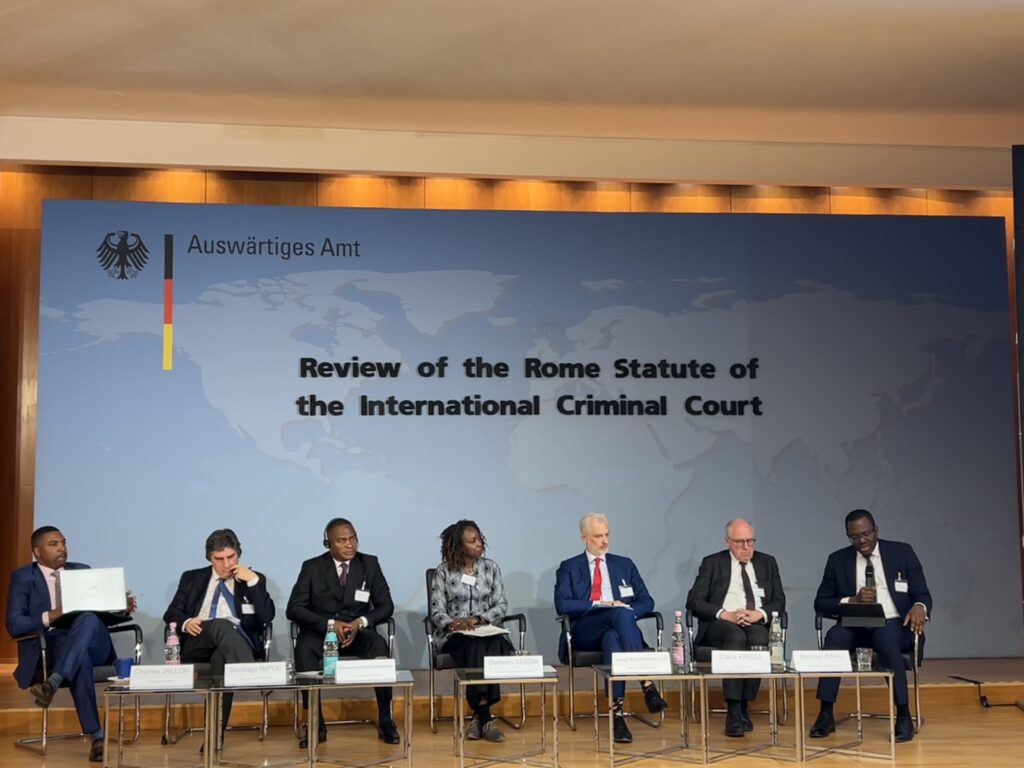Report on the Establishment of a Special International Tribunal for the Crime of Aggression
Incident Overview and Implications for Sustainable Development
On June 13, 2025, a large-scale military operation was initiated by Israel against Iran, reportedly targeting its nuclear program and resulting in attacks on various facilities, scientists, and military leaders. The ensuing twelve-day conflict led to significant civilian casualties, with Iran’s Ministry of Health and Medical Education reporting approximately 627 deaths and 4,935 injuries. This act of aggression represents a profound setback for the 2030 Agenda for Sustainable Development, directly contravening the principles of peace, justice, and human well-being.
This report analyzes the incident through the lens of international criminal law and its intersection with the Sustainable Development Goals (SDGs), focusing on the feasibility of establishing a special international tribunal to prosecute the crime of aggression. Such a measure is critical for upholding SDG 16 (Peace, Justice and Strong Institutions) and ensuring accountability for actions that destabilize global peace and security.
Impact of Military Aggression on Sustainable Development Goals
Severe Contravention of SDG 16: Peace, Justice and Strong Institutions
The military operation is a manifest violation of the United Nations Charter, undermining the foundational principles of international law and peaceful coexistence. The consequences represent a direct assault on the targets of SDG 16.
- Target 16.1 (Reduce Violence and Deaths): The reported casualties are a stark failure to protect human life and reduce violence.
- Target 16.3 (Promote Rule of Law and Access to Justice): The act of aggression challenges the international rule of law. Establishing a tribunal is a necessary response to ensure access to justice and reinforce legal norms against the unlawful use of force.
- Target 16.a (Strengthen Institutions to Prevent Violence): The incident highlights the need for stronger international mechanisms, achieved through cooperation as outlined in SDG 17 (Partnerships for the Goals), to prevent and prosecute such crimes.
Detrimental Effects on Human and Economic Well-being (SDGs 3, 8, 9)
The conflict’s impact extends beyond immediate security concerns, affecting core development goals related to health, infrastructure, and economic stability.
- SDG 3 (Good Health and Well-being): The high number of deaths and injuries places an immense burden on Iran’s health systems, directly undermining public health and well-being.
- SDG 9 (Industry, Innovation and Infrastructure): Attacks on peaceful nuclear facilities and other civilian infrastructure destroy critical assets essential for national development and innovation.
- SDG 8 (Decent Work and Economic Growth): The persistent undermining of Iran’s security and economic structure, with attacks reported across 18 provinces, disrupts economic activity and impedes progress toward sustainable growth.
Legal Analysis: The Crime of Aggression
Fulfilling the Criteria for a Crime of Aggression
For accountability to be pursued under the framework of SDG 16, the actions must be legally defined as a crime of aggression. The Israeli attack qualifies under both customary international law and the Rome Statute. The operation constitutes a “manifest violation” of the UN Charter based on its character, gravity, and scale. The bombardment of another state’s territory, the extensive scope of the operation, and the stated objective of regime change satisfy these criteria, making it a prosecutable international crime.
Proposed Mechanism for Accountability: A Special International Tribunal
Rationale and Establishment Models
Given the jurisdictional limitations of the International Criminal Court (ICC) and domestic courts in this context, a special international tribunal emerges as the most viable pathway to justice. This aligns with SDG 16’s call for effective and accountable institutions at all levels. Two primary models exist for its establishment:
- Establishment within the United Nations framework, either through a (likely unattainable) Security Council resolution or a treaty between Iran and the UN based on a General Assembly recommendation.
- Establishment via a multilateral international treaty outside the UN framework, open to all states.
The Challenge of State Official Immunity
A significant legal hurdle for any such tribunal is the immunity of state officials, particularly the personal immunity of heads of state (the Troika). Two competing legal paradigms address this challenge:
- Immunity Can Be Set Aside: One view holds that a tribunal established with sufficient international character, such as through a UN General Assembly recommendation or a widely ratified treaty, acts on behalf of the international community and can therefore override both functional and personal immunities for international crimes.
- Personal Immunity Is an Obstacle: A contrasting view argues that states cannot delegate an authority they do not possess. Since states cannot unilaterally waive the personal immunity of another state’s officials, a tribunal they create cannot do so either, unless established by a binding Security Council resolution or with the consent of the official’s home state.
Conclusion and Recommendations
A Feasible Path Forward Aligned with the SDGs
Synthesizing these legal approaches, the most pragmatic model for a special tribunal is one that mirrors the framework proposed for the crime of aggression against Ukraine. Such a tribunal could be empowered to set aside functional immunity for all officials. However, it would respect the personal immunity of serving heads of state, allowing for indictment but deferring prosecution until the official leaves office or immunity is waived.
Upholding SDG 16 and Ensuring Universal Justice
The establishment of a special international tribunal is not merely a legal exercise; it is a critical step toward fulfilling the promise of the Sustainable Development Goals. To maintain the credibility of international criminal justice and demonstrate a consistent commitment to SDG 16, the international community must support this jurisdictional pathway. Doing so would send an unequivocal message that acts of aggression will not be tolerated and that the principles of peace and justice apply universally, reinforcing the global framework for sustainable development for all.
Analysis of Sustainable Development Goals in the Article
1. Which SDGs are addressed or connected to the issues highlighted in the article?
The article primarily addresses issues related to the following Sustainable Development Goals:
- SDG 16: Peace, Justice and Strong Institutions. This is the central theme of the article. The entire text is a legal analysis of an act of aggression, the application of international law (jus ad bellum, jus in bello, the UN Charter), and the mechanisms for ensuring accountability and justice, such as establishing a special international tribunal. It directly engages with the principles of promoting peaceful societies, providing access to justice, and building effective, accountable institutions.
- SDG 3: Good Health and Well-being. The article connects to this goal by explicitly mentioning the human cost of the conflict. The reported casualties are a direct consequence of violence and impact the health and well-being of the population.
2. What specific targets under those SDGs can be identified based on the article’s content?
Based on the article’s content, the following specific targets can be identified:
-
Under SDG 16: Peace, Justice and Strong Institutions
- Target 16.1: Significantly reduce all forms of violence and related death rates everywhere. The article directly relates to this target by describing a “large-scale military operation” that resulted in “approximately 627 deaths and 4,935 injuries.” The core subject, an act of aggression, is the ultimate form of violence that this target seeks to reduce.
- Target 16.3: Promote the rule of law at the national and international levels and ensure equal access to justice for all. This target is the primary focus of the analysis. The article extensively discusses the legal frameworks for prosecuting the “crime of aggression” under international law, referencing the UN Charter and the Rome Statute. The detailed examination of establishing a “special international tribunal” and overcoming legal challenges like state immunity is fundamentally about promoting the rule of law and creating pathways for justice.
- Target 16.a: Strengthen relevant national institutions, including through international cooperation, to build capacity at all levels… to prevent violence and combat… crime. The article explores various models for establishing a special tribunal, including one “by concluding a treaty between Iran and the UN based on a General Assembly recommendation” or one “by concluding an international treaty outside the UN framework.” These are forms of international cooperation aimed at creating a strong institutional mechanism to combat the international crime of aggression.
-
Under SDG 3: Good Health and Well-being
- Target 3.d: Strengthen the capacity of all countries… for… risk reduction and management of national and global health risks. A military conflict causing mass casualties constitutes a severe national health crisis. The article’s mention that “According to Iran’s Ministry of Health and Medical Education, Israeli attacks resulted in approximately 627 deaths and 4,935 injuries” highlights the impact on the national health system and its role in managing the consequences of the conflict, which is a major health risk.
3. Are there any indicators mentioned or implied in the article that can be used to measure progress towards the identified targets?
Yes, the article mentions or implies several indicators:
-
For Target 16.1: The article provides direct quantitative data that can be used for indicators measuring conflict-related deaths.
- Indicator 16.1.2 (Conflict-related deaths per 100,000 population): The figure of “approximately 627 deaths” resulting from the military attacks is a direct measure of conflict-related deaths. The “4,935 injuries” also serve as a measure of the violent impact of the conflict.
-
For Target 16.3: While not providing quantitative data, the article’s entire narrative is a qualitative analysis of the mechanisms that indicators for this target seek to measure.
- Indicator 16.3.3 (Proportion of the population who have experienced a dispute… and who accessed a formal or informal dispute resolution mechanism): The article’s core purpose is to analyze the feasibility of different justice mechanisms (“domestic courts,” the “International Criminal Court (ICC),” and a “special international tribunal”) for the crime of aggression. This analysis directly addresses the availability and accessibility of formal dispute resolution mechanisms at the international level.
-
For Target 3.d: The article provides raw data that serves as a primary input for measuring the scale of a health crisis.
- The specific numbers of “627 deaths and 4,935 injuries” are key metrics used to assess the magnitude of a health emergency and the subsequent response required, which is central to the management of health risks mentioned in this target.
4. Summary Table of SDGs, Targets, and Indicators
| SDGs | Targets | Indicators Identified in the Article |
|---|---|---|
| SDG 16: Peace, Justice and Strong Institutions |
16.1: Significantly reduce all forms of violence and related death rates everywhere.
16.3: Promote the rule of law at the national and international levels and ensure equal access to justice for all. 16.a: Strengthen relevant national institutions, including through international cooperation, to build capacity… to… combat… crime. |
For Target 16.1: The specific count of conflict casualties (“approximately 627 deaths and 4,935 injuries”) serves as a direct measure for Indicator 16.1.2 (Conflict-related deaths).
For Target 16.3: The analysis of establishing a “special international tribunal” and assessing its jurisdiction against other bodies like the ICC directly relates to the availability of formal dispute resolution mechanisms (relevant to Indicator 16.3.3). For Target 16.a: The proposal to create a tribunal via a UN General Assembly recommendation or a multilateral treaty is a direct example of international cooperation to build judicial capacity. |
| SDG 3: Good Health and Well-being | 3.d: Strengthen the capacity of all countries… for… risk reduction and management of national and global health risks. | For Target 3.d: The data reported by the “Ministry of Health and Medical Education” on “627 deaths and 4,935 injuries” is a primary indicator of a major national health crisis resulting from conflict, which requires management and response. |
Source: opiniojuris.org







